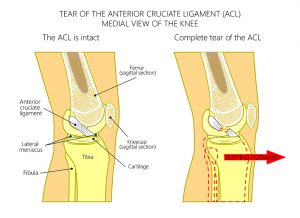What does the ACL do?
The anterior cruciate ligament (ACL) is perhaps the most important ligament in the knee is the. It runs from the front of your shinbone (tibia) to the back of your thighbone (femur), and is no bigger than your little finger. The ACL has several functions including:
- provides stability to the knee when twisting or turning.
- prevents the tibia from moving forward relative to the femur.
- crucial to activities that require quick cutting and pivoting.
What types of ACL injuries are there?
There are three degrees of ACL sprains:
- In a first-degree sprain, the ligament fibers are stretched but not torn.
- In a second-degree sprain, some of the fibers are torn while others remain intact.
- In a third-degree sprain, all of the ligament fibers are torn, resulting in a very unstable knee.
How do ACL injuries happen?
There are two common ways that the ACL is injured:
- One injury occurs when a person is running and quickly changes direction. This causes a subsequent sprain of the ligament from excessive stress.
- The second scenario involves someone or something falling onto the knee while it is fixed in place. This excessive amount of force results in a strain on the ligament.

Vector illustration anatomy of a knee joint with healthy and torn anterior cruciate ligament. Side or medial view of straight knee with sagittal section of femur bone. For medical publications. EPS 10
What are the symptoms of an ACL injury?
Symptoms of an ACL injury include:
- Hearing or feeling a “snap” or “pop” in the knee
- Immediate swelling and pain in the knee
- Difficulty walking
- Persistent knee instability, especially when running or pivoting on the knee
It is not uncommon to damage other structures in the knee with the initial ACL injury. This includes disruption of other ligaments, tendons, and/or cartilage of the knee. These other injuries can result in more pain and increased swelling, and complicate the diagnosis and treatment.
How is an ACL tear diagnosed?
In order to determine the cause of your symptoms and the extent of the injury, your doctor will ask you questions and perform a physical examination. X-rays are helpful in viewing the bony anatomy of the knee and can confirm or eliminate a diagnosis.
After your doctor has conducted the examination, he or she may recommend that you undergo more diagnostic tests, such as an MRI scan. An MRI allows your specialist to clearly see the muscles, tendons, and ligaments of the knee. This information helps him or her formulate a treatment plan tailored to your needs.